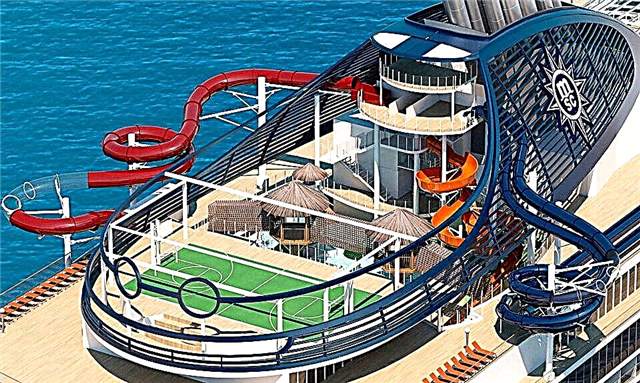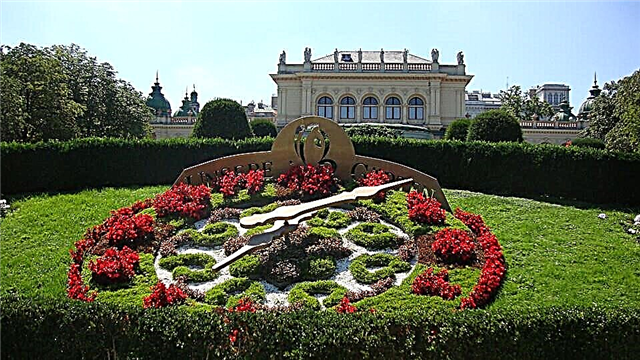Address: Russia, Pskov region, Pskov, Mirozhskaya embankment
Foundation date: in the middle of the XII century.
Founder: Saint Niphon
Main attractions: Cathedral of the Transfiguration of the Savior, Church of St. Stephen's, bell tower
Shrines: list of the miraculous Mirozhskaya icon of the Mother of God
Coordinates: 57 ° 48'23.6 "N 28 ° 19'43.4" E
Cultural heritage site of the Russian Federation
Content:
The famous Pskov Krom occupies the right bank of the Velikaya River, and on the opposite, left bank there is the no less famous Mirozhsky Monastery. It was named after the small river Mirozha, near the mouth of which old walls and temples rise. This monastery is one of the oldest in Russia. It was founded in the first half of the 12th century and has preserved ancient frescoes created by unknown Byzantine iconographers.

View of the monastery from the opposite side of the Velikaya River
History of the monastery
The monastery appeared in the city in the 1130s, thanks to the bishop of Novgorod Nifont. The saint was of Greek origin, took monastic vows at the Kiev-Pechersk monastery, and then was sent to Novgorod. He gave the new monastery a name - Spaso-Preobrazhenskaya and made sketches for the painting of the monastery churches.
Under Niphon, Novgorod architects built here the first temple - the Transfiguration Cathedral, and the Byzantine masters invited by the bishop made the paintings in it. The scenes of the Old and New Testaments became the subject of skillfully executed frescoes. It is easy to imagine the amazement experienced by all those who first came to the cathedral. Painted from top to bottom, the frescoes revealed scenes from the life of Jesus Christ to believers, showed the moment of his crucifixion, resurrection and ascension to heaven.
In the Middle Ages, the monastery on the left bank of the Velikaya one played the role of one of the cultural centers of the Pskov lands. He possessed a large library. Monks painted icons, kept chronicles and copied ancient manuscripts. Their labors created a copy of the famous "Lay of Igor's Campaign." The monastery was considered very rich - it owned the floodplain of the Mirozha and the left bank of the Great, several mills and forges, as well as household yards.

View of St. Stephen's Church
It stood outside the fortified walls of the Pskov Kremlin and therefore was vulnerable to enemies attacking from the west. So, in 1299, the Livonian knights plundered the territory of Pskov Posad and set fire to the monastery. In 1581, the Orthodox monastery, on the contrary, was used to attack the city. The King of Poland and the Grand Duke of Lithuania Stefan Batory ordered to put cannons on the monastery bell tower and from them fired at Pskov.
With the advent of Soviet power, the monastery was closed and a city excursion station was placed in it. In the mid-1990s, the Stefanov Church, as well as the fraternal and rector's corps were handed over to the believers, and they began to revive the monastic life. The first to settle here were monks who came from the famous Pskov-Pechersk monastery. Since 2010, the entire monastery ensemble, except for the Transfiguration Church, has been transferred to the jurisdiction of the Church.
Architectural monuments on the territory of the monastery
It is no coincidence that the Mirozh monastery is called an outstanding monument of medieval architecture and one of the symbols of ancient Pskov. Its snow-white walls and temples are perfectly visible from the river and make up the front facade of Zavelichye. The territory of the monastery is surrounded by a low stone fence, erected in the late 18th - early 19th centuries.

Cathedral of the Transfiguration
Many believers and tourists come here to see the ancient Transfiguration Cathedral, which has stood for almost 900 years and is considered one of the examples of Russian architecture of the pre-Mongol period. It was built of stone slabs and thin bricks - plinths. It is a cross-domed Greco-Byzantine temple with one semicircular apse and a powerful light drum with a massive head. The laconicism and simplicity of the ancient cathedral became the basis for the Pskov architectural school that developed later.
Inside the temple, you can see frescoes and inscriptions in Greek made in the middle of the 12th century. This is a rare case when ancient paintings, created using raw plaster, have survived in such a volume and quality. In the 17th century, they were whitewashed, and this was one of the reasons why the unique frescoes were not lost. The ancient paintings were uncovered at the end of the 19th century, and then they were examined and restored many times.
The monastic frescoes are recognized as a unique monument of ancient Russian monumental painting, and are currently under the protection of UNESCO. So that more people can see these murals, the cathedral is open as a museum, and services are not held in it.

Left to right: St. Stephen's, bell tower, fraternal building
In the northern part of the monastery rises the snow-white church of the Apostle and First Martyr Stephen with a bell tower. It was built at the beginning of the 17th century to replace the temple that had stood in the monastery since 1406. Stefanovskaya church is designed as a gate church with a basement. This is a whole building with a refectory and the Holy Gates adjoin it.
The decor of the church bears obvious evens of Moscow temple architecture. It looks very elegant and is richly decorated with ornamental belts, intricate cornices, platbands, shoulder blades and columns. The double-height temple covers a closed vault. Today the church is active, and services are regularly held in it. In the basement there is an exhibition of icons created by the masters of the monastery.
From the north, the monastery facade consists of the Stefanovsky Church, the Holy Gates, a high bell tower, built in 1879, and a two-story fraternal building (XVIII-XIX centuries). To the west of the main cathedral is the abbot building (XVI-XIX centuries). It consists of an old stone basement with a built-up wooden floor. Today it houses the monastery's icon-painting center.

Fraternal Corps
The monastery is located at the confluence of two rivers, and has been repeatedly flooded with flood waters throughout its long history. The last time this happened was in 2011. In April, the water rose so high that the Transfiguration Church was flooded by 1 m. To save the unique frescoes, they had to pump out the water with pumps, using the help of the Ministry of Emergency Situations.
Current state and visiting regime
Today the monastery is a functioning Orthodox monastery, living according to the strict monastic charter. Its territory is open to pilgrims and tourists every day from 8.00 to 19.00. Services are held in the church of the Apostle and First Martyr Stephen. It is not forbidden to take photos and videos here, however, travelers are asked not to take photographs of residents and church services.
For believers, there is a pilgrimage center that organizes excursions to the holy places of Pskov and the Pskov region. Male pilgrims can stay at the monastery for several days. Especially for them, there are guest cells in the monastery with conveniences, where up to five people sleep at the same time.

Abbot building
A refectory has been opened in the Stefanovsky building. She works from 10.00 to 12.00 and from 14.00 to 17.00. Here you can have breakfast, lunch and dinner for a modest donation. The monastery church shop sells icons, souvenirs with views of Pskov sights, wax candles, books and films.
The monastery is especially proud of its icon-painting workshop. Monastery residents who are professional artists work here. They work according to the traditional icon-painting canon, created in the XII century, and paint icons with tempera paints on linden boards, and for gilding they use sheets of gold leaf. The monastery fulfills many orders from other monasteries, temples and pilgrims.It is curious that in the icon painting workshop for believers and tourists, special excursions and master classes are held, where you can learn how to make wax candles and paint with egg tempera.
How to get there
The monastery stands in the center of the city, on the left bank of the Velikaya River, at the address: Mirozhskaya embankment, 2. It is not difficult to walk from the walls of the Pskov Kremlin to it in 20 minutes. To do this, you need to cross the river across the bridge named after the 50th anniversary of October (Yubileynaya street).

Holy gates
From the railway station you can get to the monastery by buses No. 2, 2A, 5 and minibus No. 2T (stop "Damba"). If you wish, you can walk from the station to the monastery (1.5 km).
If you get by car, then from the southern outskirts of Pskov from the Leningradskoe highway (highway P23) you need to turn onto Sovetskaya Armii Street, take it to the bridge over the Velikaya River (Yubileinaya Street), move to the left bank of the river and go through the arboretum to the monastery. Parking for cars is located in the southern part of the arboretum.











